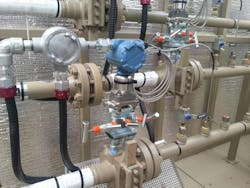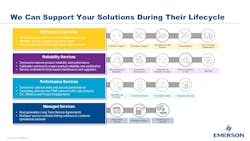Extending maintenance services into performance management
Key Highlights
- Lifecycle services extend beyond maintenance and reliability to include performance optimization, helping plants identify and address subtle inefficiencies.
- Performance evaluations involve comprehensive analysis of equipment, process data, and operational history to recommend targeted improvements.
- Digital transformation and remote expertise are crucial for modern plants to maintain competitiveness amid personnel shortages and technological advancements.
- Regular performance assessments can lead to incremental gains in output and efficiency, significantly impacting the bottom line.
- Collaborative efforts between onsite teams and offsite analysts enable proactive problem-solving and continuous process improvement.
In this third installment of a three-article series on lifecycle services, we will concentrate on performance, following the first article on maintenance, and the second on reliability.
In all three articles, we are examining the lifecycle requirements of process manufacturers as they evaluate routine make-or-buy decisions, while they take into consideration their main task, which is producing their core products. Such analysis is common for equipment but also applies to services. Typical thinking these days for many companies is pushing more tasks that were traditionally done internally to outside services as a way of supplementing their internal skilled labor pool.
The arguments in favor of lifecycle management as a service are clear because the skills required are becoming more complex, while the number of people available and capable of performing such tasks is not keeping up with the demand. The needs for maintenance are already visible, and reliability is more complex. Reliability uses preventive techniques, such as diagnostic information, to warn of impending failures so teams can minimize reactive maintenance and unscheduled outages.
Performance extends the concepts of maintenance and reliability to deliver additional operational benefits. For example, imagine this common situation: a strategic flowmeter (Figure 1) measures output from a reactor for a continuous process. It is a typical application present in some form in most process manufacturing plants.
The maintenance team looks at the flowmeter and asks, “Is it running? Yes. Is it within its calibration interval? Yes. Are there any repairs on the schedule for it? No.” Maintenance will leave well enough alone.
The reliability team will extend the analysis, asking, “Does any diagnostic data from the transmitter suggest a problem is developing? No. Do its internal verification capabilities say it is working correctly? Yes. Does any operational history data suggest anything is amiss? No.” Reliability has no reason to act, so everyone is happy. While this level of analysis is common for Emerson’s Lifecycle Services, it is often beyond what many plants do internally.
But if one of Emerson’s staff examines the flowmeter, a deeper analysis is possible:
- Is it sized and ranged correctly? (The reliability team should have verified this already.)
- Is it installed correctly, in accordance with the relevant P&ID, and in the right position with suitable piping? (Again, it should be reviewed during reliability walkdown.)
- Are there valves or fittings nearby that could interfere with accuracy?
- Is it placed in the optimum location to make this measurement?
- Does it use the best measuring technology for the application?
- Are there aspects of the process (e.g., gas entrainment) able to corrupt its accuracy?
- Is it communicating effectively with the automation host system?
- Are there other useful ancillary functions (e.g., temperature) that it could provide?
- Does the control room display for the flowmeter reflect its function and performance well?
- Does it support the process as completely as possible, providing data useful for optimization?
The list could go on. Some readers might observe that such questions go far beyond maintenance and reliability, venturing into process engineering. Although many of these questions were, or should have been, answered during the initial plant design, inevitable changes through the years make it important to revisit these and related issues periodically.
Why evaluate performance?
Although all the elements in Figure 2 were supposed to have been optimized during initial plant design, plant conditions change.
These types of changes and developments, recognized or not, could be reducing a facility’s efficiency, overall output and product quality. And just as important, who is going to see and identify the problems the plant personnel may have missed, possibly for years?
Here are four common reasons why performance suffers:
- Some better product solution options simply did not exist or were not commonly used at the time the plant was designed. Automation technology has advanced enormously in the last few years, so better solutions may have evolved.
- The process has changed significantly. Once a process manufacturing facility has been in operation for five or more years, it will have undoubtedly gone through some modifications. It may be making a different product, working with different feedstocks, different energy sources, driving higher output or dealing with other factors. Decisions made at the outset may have been perfectly valid at the time but are not anymore.
- Individual designers have personal preferences, often based on history. An engineer who has had a bad experience with a specific technology might be reluctant to use it again, even if its use in the new situation is perfectly valid.
- A facility’s personnel profile evolves. Process industries have been going through major personnel shifts for some years now with the retirement of baby boomers and their replacement with younger workers. Many plants used to rely on the human touch, with key operators knowing how to work around some inadequacies of the facility’s automation systems. Loss of such people can hobble production.
These scenarios are not mutually exclusive, as these and others may all apply in a given situation, at least to some extent. For many plants, most of the field devices and pipe fittings were selected appropriately, installed correctly and are doing their job as planned without compromising the larger operation. It is also likely that the worst performing devices and bad actors have already been corrected during earlier maintenance and reliability efforts. Identifying devices in the gray area in between, and improving performance for a given application within a production unit, is where advances can be made.
Performance as a service
The question becomes; how does a facility find those devices requiring improvement on some level to boost an individual production unit or entire plant? Often the best approach is bringing in another set of eyes for new perspective to a situation, and this is a logical extension to maintenance and reliability efforts, increasing the value of lifecycle services (Figure 3).
The second article in the series describes how a reliability program begins with a plant walkdown (Figure 4). This is a very thorough evaluation of a facility’s equipment and documentation, asking some of the same questions listed earlier in this article. When shifting to performance, the evaluation extends to cover the longer list of questions, developing a deeper understanding of how each device fits into the larger process, rather than simply verifying its functionality. It looks at supporting plant documentation and production history data to ferret out small but critical problems.
Let us go back to the flowmeter example described earlier. During a performance analysis phase, evaluating the output flowmeter will also consider what is going into the reactor. Analysts will look at historical data for the reactor to see how effectively it has been working. Let us say that operators mentioned that production dipped slightly six months ago. History shows that this coincided with an intermediate feedstock source change, bringing higher density variability than the previous supply. The flowmeter measuring input into the reactor is a highly reliable differential-pressure installation, but operators did not always compensate for density variability. A recommendation from the performance team might be changing to a Coriolis mass flowmeter to provide more accurate chemical balance control for the reactor.
Many companies have people who can perform this kind of analysis internally, and they do it regularly, at least to some extent, but many do not. With personnel reductions due to budgetary and recruitment difficulties, many units continue to operate without the opportunity to make subtle but critical improvements. Improving the instrumentation at a strategic point in a unit may increase output by one percent or more, which can make a significant contribution to the bottom line. Finding two, three or more points of such improvement can add up quickly when evaluated against proportionally small investments.
Deploying digital worker assets
Performance evaluation depends on a combination of people in the plant, working with analysts reviewing plant data and process history. Consultants onsite doing plant walkdowns report what they see and pass information to analysts offsite. There may be suspicions about a particular part of a process unit with a cluster of instrumentation. An observation that something does not look right, even if it is working, can serve as a pointer to analysts to examine how something may be affecting production.
Emerson Lifecycle Services provides people at both ends of that workflow. Our people doing the walkdown are not isolated. They are in constant contact with additional people on and offsite to perform the required analytics to determine what is happening in the plant. Sometimes the analysts offsite direct observers in the plant to look at something that seems odd. The opposite may also happen. Working together, our performance teams look for those situations where something that seems like a small problem could be causing a significant loss of output or efficiency. Fixing these types of issues, one by one, will boost the bottom line without major investments.
No need to go it alone
Companies today are increasingly adopting digital transformation technologies to maximize performance while minimizing operating costs. Our staff, and those of our clients, are therefore quickly becoming digital workers. To assist with this transition, Emerson Lifecycle Services helps facilities today, and in the future, to overcome a wide range of industry challenges. Our experience has given us an enormous knowledge base that we put to work when we partner with all types of process manufacturers. Our dedicated services increase safety, performance and availability.
Process manufacturers must deal with increasing goals, driving development of detailed technical expertise and digital skills. Unfortunately, skilled personnel needed to execute these tasks are becoming harder to find, recruit and retain. A proactive strategy is more important than ever, applying automation, continuous monitoring, performance services, remote assistance and remote access services. These services work with in-house staff to provide timely, data-driven decision making related to maintenance and repair, while ensuring safety and reliability remains intact.
Emerson has the expertise and technology to enable process manufacturers to operate safely, improve asset reliability and optimize processes, while helping optimize plant performance to achieve business goals.
About the Author

Jennifer Randles
Emerson
Jennifer Randles has an extensive background in the “as a Service” industry in both sales and marketing. As Emerson evolves its Measurement Lifecycle Services portfolio, she strives to find the message that educates, inspires, and brings Emerson and its customers together in new and mutually positive and rewarding ways. Randles is a SCRUM Master with thesis work in Lean Management and holds a Bachelor of Science degree in Journalism from Texas A&M University.



